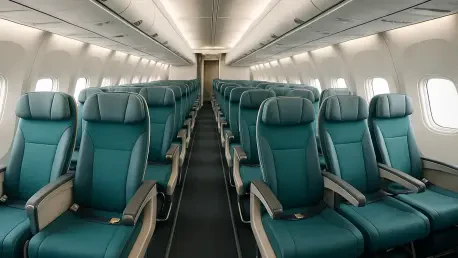Imagine stepping onto an aircraft where every detail, from the brightness of the cabin to the comfort of the seat, feels tailored to elevate your journey, regardless of your budget. WestJet, a leading Canadian airline, has embarked on an ambitious project to transform the onboard experience through a comprehensive cabin reconfiguration across its fleet of previously economy-only aircraft. This initiative isn’t just about aesthetics; it’s a strategic move to blend affordability with modernized amenities, ensuring passengers enjoy a consistent and upgraded travel environment. By addressing diverse preferences and needs, the airline aims to redefine what it means to fly with a focus on both value and comfort, setting a new standard in the competitive aviation landscape. This transformation reflects a deep commitment to enhancing every touchpoint of the passenger journey, promising a fresh perspective on air travel.
Redefining Onboard Comfort
Innovative Cabin Design Features
WestJet’s cabin overhaul introduces a refreshed interior that prioritizes a bright and airy atmosphere, creating an inviting space for travelers. The redesign incorporates new seating with adjustable headrests, improved cushioning, and enhanced back support to ensure greater comfort during flights. A fixed recline design in the Economy section preserves personal space, addressing a common passenger concern. Beyond seating, thoughtful upgrades like in-seat power sources, personal device holders for phones and tablets, and modernized lavatories and galleys elevate the overall experience. These changes aim to create a cohesive look and feel across the fleet, aligning with the airline’s mission to improve every aspect of travel. The attention to detail in these functional enhancements demonstrates a clear intent to meet modern expectations while maintaining a welcoming onboard environment for all passengers, regardless of their chosen fare.
Tailored Seating Options for Every Traveler
A key element of this transformation is the introduction of segmented seating to cater to varying comfort levels and budgets. The Premium cabin stands out with 12 ergonomically designed seats featuring contoured cushions, reclining backs, and adjustable headrests, mirroring the luxury found in WestJet’s 787-9 Dreamliner fleet. Behind this, an expanded Extended Comfort section offers 36 seats with additional legroom, separated from the standard Economy cabin by a divider for added distinction. Within Economy, seating varies from more spacious arrangements near the front to compact options at the rear, with upgraded seatback contouring to maximize legroom. Exit row seats remain a popular choice for those prioritizing space. The use of ultra-slim-line seats also allows for an extra row, optimizing capacity without sacrificing comfort. This tiered approach ensures passengers can choose the level of amenity that best suits their needs and financial considerations.
Enhancing the Travel Experience
Balancing Affordability with Premium Offerings
WestJet’s strategy in this cabin reconfiguration reflects a deliberate balance between maintaining low-cost travel and offering enhanced experiences. As highlighted by Samantha Taylor, Executive Vice-President and Chief Experience Officer, the airline continues to pioneer accessible air travel while responding to guest demand for diverse product options. This balance manifests in the tailored seating choices, where travelers can opt for the Premium cabin for added space and amenities or select more budget-friendly Economy seats with less room. Such flexibility ensures that the airline remains inclusive, catering to a wide range of passenger expectations without compromising its core value of affordability. This thoughtful approach positions WestJet as a leader in providing value-driven travel solutions that do not force passengers to choose between cost and comfort, but rather allow them to find a harmonious middle ground.
Technological Upgrades for Modern Connectivity
Complementing the physical cabin upgrades, WestJet is introducing high-speed Wi-Fi in partnership with a leading telecommunications provider, ensuring connectivity that rivals ground-based services. This streaming-level internet service, offered free to WestJet Rewards members, is being rolled out progressively across the fleet, with a target completion for all Boeing 737-800 and MAX-8 aircraft by the end of next year. This technological enhancement underscores the airline’s commitment to aligning in-flight experiences with contemporary digital expectations. Reliable connectivity allows passengers to stay productive or entertained during their journey, bridging the gap between air and ground experiences. By integrating such advancements, WestJet demonstrates a forward-thinking mindset, recognizing that modern travel extends beyond physical comfort to include seamless access to digital tools and entertainment options.
Reflecting on a Transformative Journey
A Milestone in Passenger-Centric Innovation
Looking back, WestJet’s comprehensive cabin refresh marked a significant chapter in redefining air travel through thoughtful design and innovation. The initiative successfully modernized the fleet with aesthetic and functional improvements, ensuring a consistent experience across all aircraft. By introducing a tiered seating model, the airline addressed a spectrum of traveler needs, from premium comfort to budget-friendly options. This adaptability showcased an acute understanding of diverse passenger expectations, setting a benchmark for personalized service. The integration of advanced connectivity solutions further highlighted WestJet’s responsiveness to modern demands, proving that even small details could transform the journey. This overhaul was not just an upgrade but a bold statement of intent to prioritize guest satisfaction at every level, leaving a lasting impact on how travel could be both accessible and enjoyable.
Setting the Stage for Future Advancements
Reflecting on this transformation, it became evident that WestJet had laid a strong foundation for future innovations in the aviation sector. The successful merging of affordability with premium offerings opened doors to further explore how technology and design could enhance passenger experiences. Moving forward, the focus could shift toward integrating sustainable practices into cabin designs or expanding digital services to offer even more personalized interactions. Stakeholders and industry observers might consider how such initiatives could inspire broader trends, encouraging other airlines to adopt similar passenger-centric strategies. WestJet’s journey served as a reminder that continuous improvement in service delivery remains crucial in a competitive market. By building on this milestone, the airline positioned itself to anticipate and shape future traveler needs, ensuring that every flight remained a step toward greater satisfaction and loyalty.









